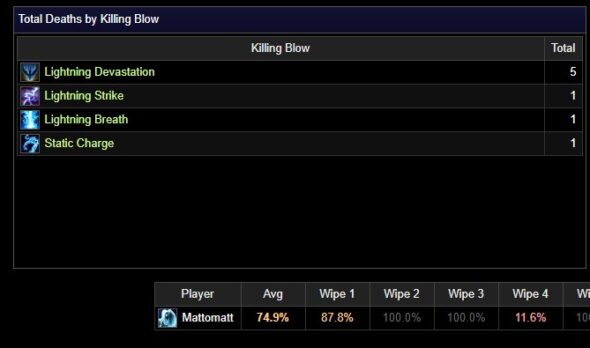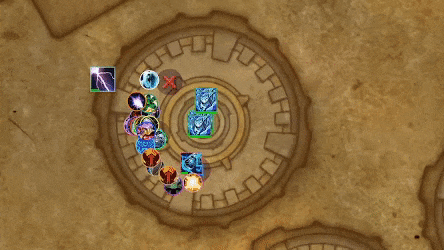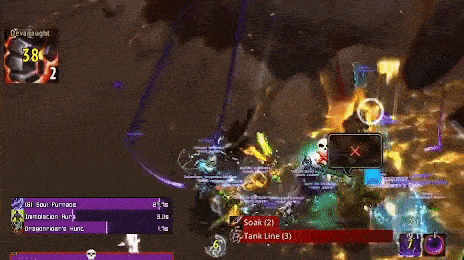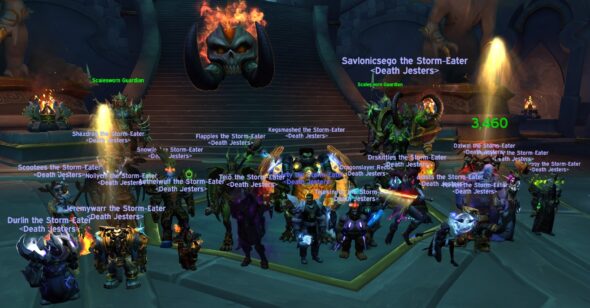This is a two part series on advancing from being an AotC player to a CE (Cutting Edge) player from both the player and guild perspective. Today, we look at the guild leadership side and how to level up the organization.
After covering what individual-minded players pursue in their goal of Cutting Edge, we’re looking at the guild organization and leadership structure. Players can’t do it alone. They need a strong team of officers and player assistants to really enable the raid to get that elusive achievement. Don’t expect this to be an overnight process. It’s better to take the time to find the right people then to rush people into roles. It’s often harder to cut after someone’s been ingrained into the roster or officer teams. My experience in raiding with groups that could never make that fated leap upwards beyond AotC or early and mid-Mythic raids has been the unwillingness to make difficult decisions.
Roster Size
Let’s start with the roster. A healthy roster size is anywhere from 24 to 27 players for Mythic Raiding. Absences are bound to happen. I’ve had days where the raid groups h ad players sign out in advance but then a few of our starters experienced storms in the area causing them to be unable to log in. The inability to raid due to attendance is one of the worst feelings in the world at this level.
Try to set your lineups in advance, if possible. Some players won’t like being sat on farm or progression but that is a necessity at this level and circles back to expectation management during the trial phase or interview step of any new applicant. If they’re not willing to sit when asked to do so, then they may not be compatible with the guild’s goals. Managing any roster lineups is a different story and will be expanded upon in a future post.
Of course, you can’t have a large roster size without…
Recruiting
There are so many resources out there when it comes to recruiting that I feel it’s expanded in scope beyond what one person can do. You need 2 or even 3 people to help manage it for one raid group at this level.
I stay in touch with our leadership team once a week to determine what our roster needs are or will be. It’s not always about adding new players as there are times when we need to replace existing players
Such reasons include:
- Burnout
- Raid retirement
- Attendance
- Skill deficiency
- Class or role requirements
As part of the recruiting team, my responsibility is to use Raider IO, Warcraft Logs, and the WoW forums to headhunt players that match our needs. Sometimes I watch Reddit (r/wowguilds and the r/wow weekly recruiting thread). I take care of first contact and direct potential players to our application form. Another officer pops into the WoW Recruitment Discord where they keep our guild information up to date and scan for any players that might fit our team. Lastly, our GM handles the interviews for any applicants who catch our interest. Sometimes a few of us will sit in and listen to the conversation.
Even if the roster is full, keep looking out for good people to add. There may not be room for them now, but they can be sought after later if a slot does open up. We’ve reached back out to players who applied weeks before when that class was full only for it to open up later to see if they were still searching for a team.
Preparation
Despite being a 2-day CE guild that only raids 6 hours a week, what isn’t often shown is the preparation that occurs outside of raid nights. There is a large amount of discussion and questions in our individual boss threads with pinned messages and links to everything. We game plan together what needs to happen individually or as a group at each stage of the encounter so that no one is caught off guard or unaware. This can include screenshots and map diagrams to coordinate positional movement. Raszageth was a masterpiece. A Sistine Chapel’s worth of planning went into it as every offensive cooldown, interrupt, and defensive was meticulously laid out.
Loot Council
Won’t touch on this one too much, but if the group wants to ensure efficient progression in a raid, loot has to be distributed effectively. It’s not always going to be fair and sometimes the council gets it wrong. Upgrades have to be maximized to give the raid a fighting chance at the next boss. Can’t leave this stuff to the need before greed or random rolls.
Related posts
Raid Approach and Attitude
Also known as expectation management! Be as consistent and transparent as possible when it comes to goals and the path to them. Our BoEs are sold to help fund consumables and pay for our repairs. Augment Runes are expensive. Any attendance requirements should be stated. We ask our players to be online 15 minutes early before the raid. Set those raid goals so everyone knows. Is there a requirement for a number of keys done per week? Yes, but what that number is will fall upon your officers to decide.
Ego management is another aspect that needs to be addressed. Players handle criticism in a variety of different ways. I prefer being chewed out publically because I enjoy it. It also sets an example for someone else to not make the same mistake I made. Others may not prefer the spotlight or could feel embarrassed. Players like that may require a softer touch and should be DM’d in private. Be prepared for raiders to push back if you ask them to do something. We had some friction when we asked a player to burn cooldowns on a shield instead of the boss because they were holding back damage for it. It wasn’t optimal (or fun), but it had to happen or else we weren’t going to get very far. This one player had to make the sacrifice for the purpose of progression.
When it comes to correcting mistakes and issuing criticism, the method I prefer focuses on the action that was missed instead of those who didn’t do it. Don’t say the interrupt was missed by Beethoven. I would instead remind the team that the interrupt order is Liszt, Bach, and Beethoven in that sequence.
Any missed assignments by the same player will get asked, “What is going on or preventing you from doing what needs to be done?”. If that’s not enough, Beethoven gets taken off the kick rotation for Chopin instead (Sometimes you need a Piano composer). Re-emphasize the consequences if an interrupt is not used at the right time like lethal damage.
Role Channels
This is an easy logistics setup. Make dedicated role channels in the game. We have a combined channel for tanks and healers to discuss defensive usages. A channel for ranged DPS and a separate one for melee help. If you have players on different servers, use the new community function to invite players, then add the channel to your chat windows. The moderation tools are a bonus.
Efficiency
Being a two-day guild means we have to maximize our time. It means burning trash packs fast or taking short scheduled breaks. Any bathroom runs could be done during trash pulls (just put a healer on follow before you do).
Figure out how to wipe fast on encounters so repeat pulls can be done. Raid leaders have to balance a wipe call against extending the pull to see more information like the next phase or give the raid some practice repetitions.
Play together
Encourage people to play together and get their keys in. If there’s seven players knocking 20’s but the other thirteen are lagging behind with 15’s, it’s hard to move up together and creates a bit of an imbalance with raid progression. We use the WoW audit sheet that shows everyone’s completed activities. It can be hard to find a time where everyone has a window especially when navigating timezones and other obligations.
Delegate and Elevate
It’s a challenge to put everything on one person when it comes to strategy and playcalling. Here we tend to spread around that workload. Our GM does a great job of asking for volunteers (and if not, volun-telling them to contribute). An example:
- Rachmaninoff: Raid leader and determines lineup. Will review composition on a per boss basis to decide which players are necessary for what encounters and balance it versus any loot related needs.
- Mozart: 21st Raider. During progression, helps with key reminders and callouts while watching a player perspective on Discord.
- Chopin: Strategy (6 bosses).
- Bach: Strategy (Remaining 2 bosses).
- Liszt: Healing cooldowns. Uses Viserio’s raid cooldown sheet to help with that.
- Tchaikovsky: Interrupts and DPS CDs (End boss). The end boss usually needs more planning work.
This spaces out everything and we can all review each other’s contributions to ensure nothing gets missed.
There is a whole raid team that is willing to step up and help. Use them! The trick to asking for help is to be specific about it. I found that asking for volunteers, in general, doesn’t lead to much traction, but asking for assistance with defensive cooldowns on one boss or helping split platform groups is enough as they’re both relatively small tasks.
Embrace the Suck
Not everyone likes to do any farming or reputation grinds. For us, the expectation isn’t to try to rush through and hit any reputation checkpoints immediately, but you are expected to some progress into it.
I’ve seen guilds without any key mandates. I’m not too fond of it myself, but if the plan is to raid in mythic or higher, then the raiders have to get some key time in. When I see raid groups who have the goal of securing AotC and pushing into Mythic, it is appalling to me that those raiders outright refuse to do keys to try to secure vault slots for their gear upgrades. At the CE level, it is a requirement because that higher-level gear gives you raw stats and stamina to help get through damage and survivability checks.
Our expectations start with a minimum of two boxes (or four completed keys) done at a reasonably high level. We asked ourselves, what can a raider with family and job responsibilities reasonably do on a weekly basis in addition to raids? That’s how we settled on at least four keys. For season 2, there is no expectation of scoring eight 20 keys during the first week. We’re a group of working professionals and post-secondary students. As the tier progresses and our characters get more equipped, the expectation is relaxed to one key per week instead.
I trust that will help aspiring CE leaders understand what it takes to propel their guild. I can guarantee it won’t be easy, but with the right players and support network, it is achievable. This post isn’t all-encompassing, but if any leaders are stuck and wondering what to do next, I find it helps to ask this question.
Which decision best helps us achieve CE? What do we give up in order to do that?
For the players who want to play at the CE level, check out my recent post: Advancing from an AotC Raider to a CE Raider.




